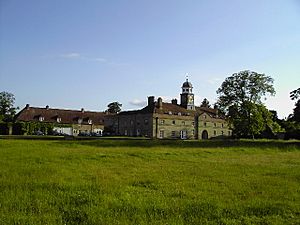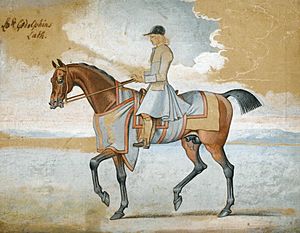Godolphin Arabian facts for kids
The Godolphin Arabian (born around 1724, died 1753) was a very famous horse. He was one of three main stallions who helped create the modern Thoroughbred horse breed. The other two were the Darley Arabian and the Byerley Turk. He was also known as the Godolphin Barb. He got his name from his most famous owner, Francis Godolphin, 2nd Earl of Godolphin.
Contents
Where the Godolphin Arabian Came From

The Godolphin Arabian was born around 1724 in Yemen. He moved several times before he came to England. When he was young, he was sent to the horse farm of the ruler of Tunis. From there, he was given to Louis XV of France in 1730 as a gift from one ruler to another.
However, the French king did not seem to value him. It is believed the horse was used to pull carts. Later, Edward Coke, Viscount Coke brought the horse from France to his farm in Longford Hall, Derbyshire, England. The horse stayed there until Coke died in 1733.
After Coke's death, the Godolphin Arabian was bought by Francis Godolphin, 2nd Earl of Godolphin. He lived at Godolphin's farm in Babraham, Cambridgeshire, until he died on Christmas Day in 1753. A special stone marks his grave under the archway of the stable block at Wandlebury House.
What the Godolphin Arabian Looked Like
The Godolphin Arabian was a bay color, which means he was reddish-brown. He had some white on one of his back heels. He stood about 15 hands tall, which is a way to measure a horse's height.
He was special because of his very high "crest," which is the top part of his neck. You can easily see this in pictures of him. Most of his immediate offspring, or foals, were also bay in color. A horse doctor named Osmer once described him as being perfectly built for racing.
How the Godolphin Arabian Became a Famous Sire
The Godolphin Arabian became a "leading sire" in Great Britain and Ireland in 1738, 1745, and 1747. This means his offspring won the most races in those years.
At first, this smaller stallion was not thought to be as good as the larger European horses. He was not meant to be a main breeding horse. Instead, he was used as a "teaser." A teaser stallion helps check if a mare (female horse) is ready to breed with another stallion.
But things changed when a mare named Lady Roxana was brought to the farm. She was supposed to breed with a stallion called Hobgoblin. However, Lady Roxana did not want to breed with Hobgoblin. So, the Godolphin Arabian was allowed to breed with her instead.
This breeding led to Lath, the first of the Godolphin Arabian's famous foals. Lath went on to win the Queen's Plate nine times at the Newmarket Racecourse. The second foal from this pair was Cade, and the third was Regulus. All three of these colts were the same gold-touched bay color as their father. They also had the same small build and high-crested neck.
All of them were incredibly fast on the racetrack. They also went on to have many successful foals themselves. This was the beginning of the Godolphin Arabian's fame as a breeding stallion. He spent the rest of his life as the Earl of Godolphin's most prized horse, breeding with England's best mares.
The Godolphin Arabian's influence also reached America. His daughter, Selima, was born in 1745. She was bought by Benjamin Tasker Jr. and brought to Colonial America. She raced between 1750 and 1753. Selima won a very large prize of 2,500 pistoles in Gloucester, Virginia. This win started the famous racing contests between the colonies of Maryland and Virginia. After her racing career, Selima became a successful breeding mare at the Belair Stud in Collington, Maryland.
The Godolphin Arabian died on the Gog Magog Hills in Cambridgeshire in 1753. He was about 29 years old. You can visit his grave in the stable block of Wandlebury House. When he was buried, people celebrated the occasion with ale and cake.
The Godolphin Arabian's Lasting Impact
Today, most Thoroughbred horses trace their male family line back to the Darley Arabian. However, several famous North American horses from the past trace their male line back to the Godolphin Arabian. These include well-known horses like Seabiscuit, Man o' War, and War Admiral. Today, his male line continues mainly through horses like Relaunch and his son Tizzy, who sired the famous Breeders' Cup Classic winner Tiznow.
In Europe, the Godolphin Arabian's influence mostly comes through the horse Known Fact, who won the 2,000 Guineas race. Known Fact's son, Warning, was also a champion. This family line has produced excellent sprinters (fast short-distance runners) like Diktat and Dream Ahead. The Epsom Derby race has not been won by a horse from the Godolphin Arabian's direct male line since Santa Claus in 1964.
Even though the Darley Arabian's male line is more common, the Godolphin Arabian is still very important. For example, the major Thoroughbred sire Eclipse traces his male line to the Darley Arabian. But Eclipse's mother was a daughter of Regulus, which means she was a descendant of the Godolphin Arabian. This shows that the Godolphin Arabian is often found in the female lines and in the middle of horse family trees.
The Godolphin Arabian in Stories
King of the Wind (published in 1948) is a fictional story about the Godolphin Arabian. It was written by American author Marguerite Henry. She wrote many books about horses for children, and she is also known for Misty of Chincoteague. Marguerite Henry won the Newbery Medal for King of the Wind. This award recognizes it as the best contribution to American literature for children that year.
Misty was made into a film in 1961. However, King of the Wind had to wait until 1990 for its own movie adaptation. In the film, Navin Chowdhry played Agba, the Arabian's stable boy who stayed with him his whole life.
In the novel, the Godolphin Arabian was born in Morocco and was called Sham. He came to Europe as a gift for King Louis XV of France. But because he was in poor condition when he arrived and was quite small, he was given to the king's cook to be a cart horse. He was soon sold to a woodcarter in Paris, where he was not treated well. Then, he was bought by Edward Coke and later sold to Francis Godolphin, 2nd Earl of Godolphin. The Earl had a horse farm in Suffolk, near the racing town of Newmarket.


